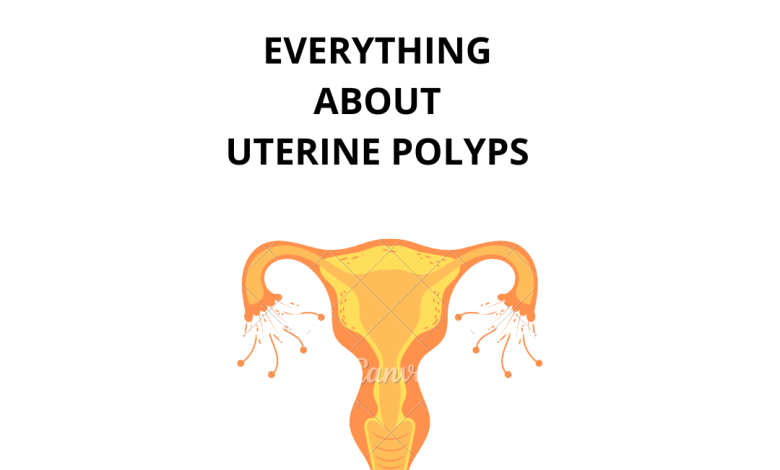Uterine polyps- know everything about this.

What are Uterine polyps?
Uterine polyps are developments appended to the inward mass of the uterus that ventures into the uterus. Uterine polyps, otherwise called endometrial polyps, structure because of cells in the coating of the uterus (endometrium) congesting. These polyps are typically noncancerous (harmless), albeit some can be dangerous or can transform into malignant growth (precancerous polyps).
Uterine polyps range in size from a couple of millimeters no bigger than a sesame seed to a few centimeters — golf-ball-size or bigger. They connect to the uterine wall by a huge base or a slight tail.
There can be one or numerous uterine polyps. They normally stay inside the uterus, yet they can fall through the launch of the uterus (cervix) into the vagina. Uterine polyps are most normal in individuals who are going through or have finished menopause. However, more youthful individuals can get them, as well.
Symptoms of Uterine polyps-
Signs and side effects of uterine polyps include:
- Vaginal draining after menopause.
- Draining between periods.
- Incessant, eccentric periods whose lengths and weight fluctuate.
- Exceptionally weighty periods.
- Barrenness.
- Certain individuals have just light draining or spotting; others are side effect free.
If you have any of the above symptoms then you may take an appointment at the best IVF centre in Srinagar.
When to see a doctor
Seek medical care if you have:
- Vaginal bleeding after menopause.
- Bleeding between periods.
- Irregular menstrual bleeding.
See the expert at the best ivf clinic in Srinagar.
Causes of Uterine polyps?
Hormonal elements seem to assume a part. Uterine polyps are estrogen-delicate, meaning they fill in light of estrogen in the body.
Risk factors
Risk factors for creating uterine polyps include:
- Being perimenopausal or postmenopausal.
- Being large.
- Taking tamoxifen, a medication treatment for bosom malignant growth.
- Taking chemical treatment for menopause side effects.
Problems
Uterine polyps may be related to fruitlessness. Assuming that you have uterine polyps and you can’t have kids, the expulsion of the polyps could permit you to become pregnant, yet the information is uncertain.
Diagnosis –
Transvaginal ultrasound.
A slim, wandlike gadget set in the vagina discharges sound waves and makes a picture of the uterus, including its inner parts. A polyp may be obviously present or there may be an area of thickened endometrial tissue.
A connected system-
known as hysterosonography likewise called sonohysterography, includes having salt water (saline) infused into the uterus through a little cylinder put through the vagina and cervix. The saline extends the uterus, which gives a more clear perspective within the uterus during the ultrasound.
Hysteroscopy-
This includes embedding a slight, adaptable, lit telescope (hysteroscope) through the vagina and cervix into the uterus. Hysteroscopy takes into consideration seeing within the uterus.
Endometrial biopsy.-
A pull catheter inside the uterus gathers an example for lab testing. Uterine polyps may be affirmed by an endometrial biopsy, however, the biopsy could likewise miss the polyp.
Most uterine polyps are harmless
This implies that they’re not malignant growth. Yet, a few precancerous changes of the uterus called endometrial hyperplasia, or uterine tumors show up as uterine polyps. A tissue test of the eliminated polyp is dissected for indications of malignant growth.
Treatment-
Vigilant pausing.
Little polyps without side effects could determine all alone. Therapy of little polyps is superfluous for individuals who aren’t in danger of uterine disease.
Medicine. –
Certain hormonal drugs, including progestins and gonadotropin-delivering chemical agonists, may decrease the side effects of the polyp. Be that as it may, taking such drugs is normally a momentary arrangement, best case scenario, — side effects ordinarily repeat once the medication is halted.
Careful removal.-
During hysteroscopy, instruments embedded through the gadget used to see inside the uterus (hysteroscope) make it conceivable to eliminate polyps. The eliminated polyp will probably be shipped off a lab for assessment.
Planning for your arrangement
Your most memorable arrangement will probably accompany your essential consideration supplier or a gynecologist. Have a relative or companion go with you, if conceivable. This can assist you with recalling the data you get.
Make a rundown of the accompanying:
Your side effects, even those you don’t believe are connected, and when they started.
All meds, nutrients, and enhancements you take, including portions.
Inquiries to pose to your supplier.
For uterine polyps, a few essential inquiries to pose include:
What could be causing my side effects?
- What tests could I want?
- Are drugs accessible to treat my condition?
- Under what conditions do you suggest a medical procedure?
- Might uterine polyps at any point influence my capacity to become pregnant?
- Will treatment of uterine polyps work on my fruitfulness?
- Might uterine polyps at any point be carcinogenic?
What to expect from an expert?
A few inquiries your supplier could pose include:
- How frequently do you have side effects?
- How serious are your side effects?
- Does anything appear to work on your side effects?
- Does anything appear to exacerbate your side effects?
- Have you been treated for uterine polyps or cervical polyps previously?
- Have you had fruitfulness issues? Would you like to become pregnant?
- Does your family have a background marked by bosom, colon, or endometrial disease?
Also, read – https://magazinewatches.com/what-are-the-fundamentals-to-verify-your-documents/





